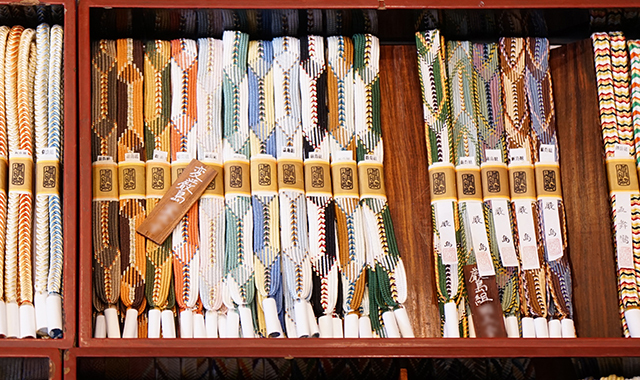
Kiichiro Domyo, Yusoku Kumihimo Domyo
We talked with Kiichiro Domyo, Yusoku Kumihimo Domyo (Domyo Co., Ltd.). (Interview: June 29, 2018)
About the history and origin of Kumihimo
Q: Could you tell me about the history of Kumihimo? What kind of purposes was Kumihimo originally used for?
Domyo: Our company was established in the early Edo Period, and since Kumihimo was introduced into Japan along with Buddhism, so it was originally used for Buddhist ceremonies. In the Heian Period, it began to be used for costumes for nobles, and for "Oyoroi," an armor, at the end of the Heian Period.
From ancient times, it has been used for a variety of uses, including men's formal belts. With the emergence of samurai warriors, it was also used for arms.
Q: I see many scenes in which Kumihimo is used for portable shrines and drums in festivals. Is it one of the uses of Kumihimo?
Yes. Sometimes, historic and sophisticated pieces of Kumihimo are used for "Agemaki," an ornament for a portable shrine. I have once surveyed those ornaments. (continued in the lower column)
Q: Are you generally making Kumihimo products tailored to orders?
In some cases, we custom-make Kumihimo products. If historic Kumihimo is newly found somewhere, or I have particular occasions in which, for example, I see a Kumihimo product at an exhibition for the first time, I go to see those products in order to study and reproduce them.
Q: Do you occasionally go abroad to research Kumihimo products?
About 20 years ago, my father frequently visited Dunhuang and the Western Regions of China to survey various things. Compared to Japanese Kumihimo, pieces of Kumihimo found in those regions have primitive dynamism.
Q: Minority races in southern China also make Kumihimo, don't they? Clothing makers in Japan also take advantage of crepe techniques such as Steam Stretch.
Chinese use intriguing Kumidai to make Kumihimo. My mother also went to China to survey Kumihimo, and bought Chinese Kumidai.
Q: Do you still make Kumihimo products related to Buddhist altar fittings?
Although there are not so many orders for products used for Buddhist altar fittings, we sometimes receive commissions to reproduce Kumihimo products that are attached to Buddhist fittings, such as old national treasures. Products of culture, such as Kumihimo and textiles, are preserved in Shoso-in in Nara, and the most common items among those products are kimono belts. "Ban," a Buddhist ornament hung on walls of a temple, is also preserved. We sometimes make Kumihimo based on those products.
Q: When you reproduce Kumihimo, do you use the same materials as ones at that time?
Yes. We prepare threads that have the same composition as the old ones as well as colors and twisted threads as much as possible, and strive to reproduce Kumihimo by using exactly the same braiding method.
Q: Do Japanese Kumihimo also derives from Kyoto?
It seems that, since Kumihimo was used for a variety of purposes, it has been created nationwide, not limited to Kyoto. I think there were Kumihimo studios in many regions, but many of historic Kumihimo products have been preserved in regions around Kyoto. (continued in the right column)
Since we try to accumulate all Kumihimo techniques in Japan, we distance ourselves from particular schools.
Q: Styles of bamboo blinds differ between the Kyoto and Edo (Tokyo) styles. Is there such difference in Kumihimo?
I am not sure. The Edo style might have smartness in design, Edo-ish patterns and clear dynamism.
I think Kumihimo is now being braided in the same way between the Kyoto and Edo styles, but preferences of colors might be different. In Kyoto, soft ombre dyeing and elegant colors are usually preferred. We are also not so obsessive about the Edo Kumihimo, and try all kinds of braiding methods.
Q: How are the circumstances of the present Kumihimo industry in Japan going?
There are a few large companies.
Q: By the way, is Kumihimo taught at Tokyo University of the Arts?
I think textiles are taught, but not Kumihimo. (continued in the lower column)

About materials of Kumihimo
Q: Have silk threads been used for Kumihimo since early times?
Most pieces of Kumihimo that were imported and preserved are made of silk threads. Kumihimo originated from Central Asia and the interior of China. Many pieces of Kumihimo that were used for folk costumes in those regions are made of wool. However, Japanese Kumihimo is made of silk threads.
Q: Are a variety of materials, such as cotton and wool, used around the world? Do only Japanese use silk threads to make Kumihimo?
I think, in South America and Andes regions, they use a variety of materials, but in China, South Korea and Japan, silk threads are used to make Kumihimo.
Q: Do you procure materials for Kumihimo within the country?
Recently, domestic output of silk has decreased. The amount of domestically produced silk on the market is about 0.5%, and we buy one fiftieth of it. We use domestic and foreign silk in a ratio of one to three. When the domestic silk industry thrived, we used domestic silk. However, its production has now decreased, so we use foreign silk together with domestic one.
Q: What countries are major silk producers?
They are Brazil and China. China has produced silk on a large scale, and gained a large market share in the world. It has also advanced technologically in recently years, so manufacturing systems in China are fairly modernized.
One feature of domestic silk is that it is whiter than foreign one. Chinese silk is little bit reddish. Although scarves of Hermes, a French brand, were made of Brazilian silk, I have heard that production of Brazilian silk has also decreased.
Q: Do you use synthetic fibers other than silk?
I think fibers, such as a polyester, can be used for inexpensive sash bands. (continued in the next page)

Kiichiro Domyo, Yusoku Kumihimo Domyo














